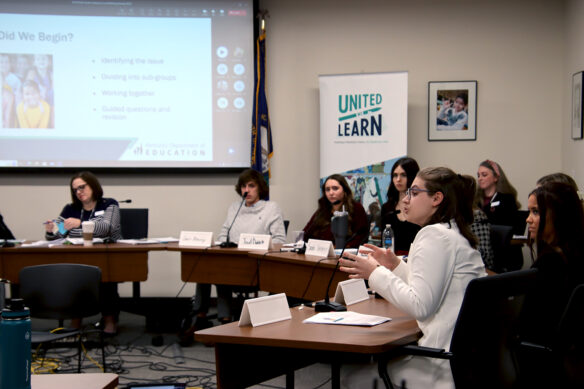
Commissioner’s Student Advisory Council member Malley Taylor, a junior at Craft Academy (Rowan County), speaks during the council’s meeting on Jan. 24, 2023. The council presented a report on potential actions to increase school safety. “We realized we needed to use our voices for change,” Taylor said.
Photo by Joe Ragusa, Kentucky Department of Education, Jan. 24, 2023
The Kentucky Department of Education’s Commissioner’s Student Advisory Council presented a report on potential actions to increase school safety during its meeting on Jan. 24.
State Rep. James Tipton, chairman of the House Education Committee, was in attendance to hear the recommendations, which he said he plans to discuss further with other lawmakers.
“Hopefully we can make some improvements to what we’re currently doing through this process,” he said.
The report follows a year where schools experienced 170 incidents of gunfire on school grounds, according to Everytown Research and Policy. Those incidents resulted in 55 deaths and 145 injuries.
Council member Peter Jefferson, a sophomore at Henry Clay High School (Fayette County), said he and his fellow council members wanted to make an impact on what is a growing problem in schools.
“Something is happening,” he said of violent incidents in schools. “How can we make sure that it doesn’t happen for us and minimize the effects of it if it does?”
The Commissioner’s Student Advisory Council started looking at potential recommendations for lawmakers following the school shooting in Uvalde, Texas, in May 2022.
“We all had a lot of big emotions and we needed somewhere to put that,” said council member Malley Taylor, a junior at Craft Academy (Rowan County). “We realized we needed to use our voices for change.”
Members conducted research independently that summer and held discussions in breakout groups to develop a list of potential policy changes. The breakout groups focused on three different categories of recommendations: before an incident, during an incident and after an incident.
“Our main goal is to make sure that everyone is getting a quality education,” said council member Joud Dahleh, a senior at Ignite Academy (Boone County). “And you cannot have a quality education if you do not feel safe in your school building.”
Before an Incident
Council members suggested three things to prevent school violence:
- Promote the STOP Tipline.
- Improve the rate of intervention in concerning behaviors.
- Support gun control.
The council highlighted the STOP Tipline because it must be available to schools through state statute, but the current law does not say anything about promoting it to students, which can be a crucial step toward picking up on warning signs being displayed by a student.
Improving the intervention rate builds on the rationale behind the STOP tipline: address issues like bullying or disciplinary actions early so problems do not build over time.
Members of the council also proposed supporting gun control legislation that would require a mental health screening to purchase certain firearms.
During an Incident
The council also recommended changes focused on preparation and notification during a school violence incident:
- Improve active shooter drills.
- Improve training for first responders.
- Establish a clear notification system for students and parents.
Citing research from the “Journal of Adolescent Health,” council members said the majority of active shooter drills are ineffective and sometimes do more harm than good. Council members also said majority of students feel they did not understand the benefits of active shooter drills and felt emotional distress because of them. The students recommended drills that offer a more realistic simulation of an active shooter situation.
The circumstances surrounding the school shooting in Uvalde, Texas, prompted the recommendation to improve training for staff, first responders and school resource officers. The council suggested setting up a training center specifically designed to train law enforcement how to respond to mass shootings, like the Frank Deangelis Center for Community Safety in Wheat Ridge, Colo., to streamline and bolster training efforts.
In terms of notification, the council suggested expanding the Infinite Campus system Kentucky already uses to communicate with parents to push out details about active threats and drills, and allow for two-way communication between school administrators and people directly impacted by an emergency.
After an Incident
The Commissioner’s Student Advisory Council also focused on how to prepare to support a community affected by an act of violence at a school:
- Provide mental health support.
- Host town hall meetings.
- Repair and rebuild the school building.
The council said school-based crisis intervention teams need to be in place following a tragedy to support the needs of members of the community, some of whom may develop post-traumatic stress disorder. Greater access to therapy and counseling services also was part of the recommendation.
Discussion within the greater community is also key after a violent event happens, which is why the council recommended holding town-hall style meetings with local mental health specialists to promote collective healing. Formal group therapy sessions are another method to achieve the same goal.
The council also requested more state resources toward repairing and rebuilding school buildings after an act of violence, including a new emergency fund.
Education Commissioner Jason E. Glass said the voices of students on these issues are critical.
“We’re proud of the work that they’ve done,” he said. “I think they’ve shown how capable Kentucky students are at pulling together policy recommendations that are smart, well-vetted and well-researched.”
READ MORE:




Leave A Comment